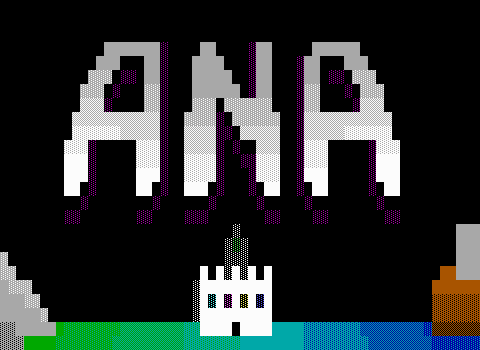
Benco's release of Ana is something that I'm really excited to be writing about. ZZT in the year 2017 is something where the few games produced tend to be made with the purpose of "I want there to be a new ZZT game" rather than "I want to make a game, and ZZT will work for what I want to make". Ana feels like the latter, where it takes a look at the things ZZT can do well, and weaves together a wonderful experience that can play both the role of a ZZT game as well as that of a modern indie title.
This game is the first new addition to the list of Featured Games in years and has more than earned its spot. Ana consists of three components, the story, the puzzles, and the soundtrack. Each piece on its own would be notable, but combined together create something that feels special. Let's take an overview of each component and see how Benco manages to elicit feelings that few other ZZT worlds ever could.
The Story
The game's accompanying text file simple states that "you play as Ana, a girl who is lost in a strange world". The game opens in a small hub with a few landmarks nearby: a mountain cave, an industrial area, forest ruins, and a large white cathedral overlooking the rest. Only two of the paths can be accessed from the start, Mount Heartache and Mechanical Heights. Once these are completed the Felt Forest can be visited, and finally with every area complete the player can access the Palace of Self-Preservation
Throughout each of these locations are numerous half-block objects that can be touched for a brief snippet of story. Each area has its own story to tell, ranging from Ana's struggles with math class to her father becoming unemployed and the relationship struggles between her parents afterwards.
The story is revealed by reproductions of letters, text messages, and e-mails between the characters. These are dispersed throughout the puzzles of each board and do a fantastic job of motivating the player to keep going and solve each board.
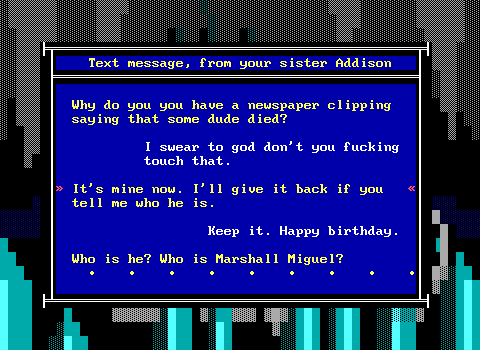
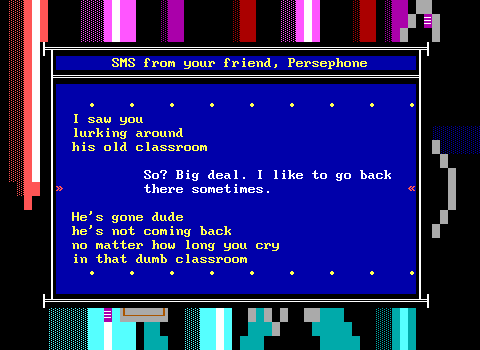
I found myself very invested in these stories and their slow reveals. Benco does an excellent job creating tension and mystery as the storylines unfold. There's often a sense of unease, likely enhanced by the fact that the gameplay doesn't give context to why these stories are being told.
The story evokes similar feelings to Gone Home by Fullbright games. Much like you're motivated to figure out what's been going on from the pieces provided exploring the home there, you'll find yourself pressing forward through Ana with that same sense of needing to find out what happens next. It's compelling enough that if the game was simply moving from one text message to the next it would still be something to play for yourself.
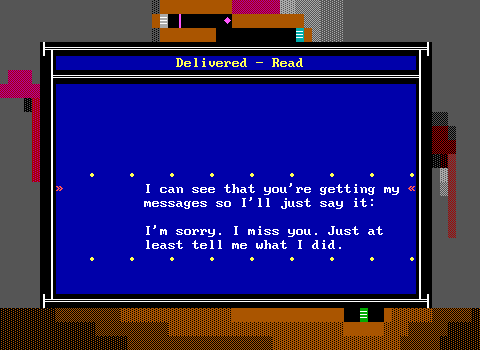
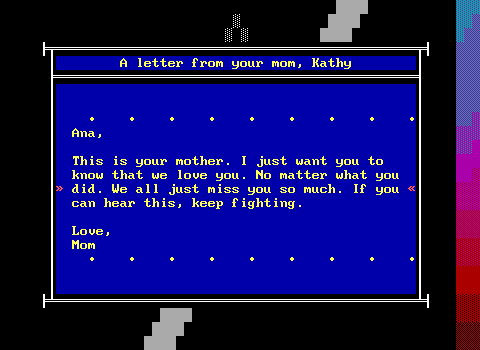
The Puzzles
The story of Ana is wonderful, but would work just as well outside of ZZT. The puzzles however, grasp ZZT's strengths in a way that just would not have the same impact in another medium.
Each of the game's regions features a unique type of puzzle, and all of them are engaging, reasonably challenging, and utilize ZZT's innate mechanics to create an extremely polished experience.
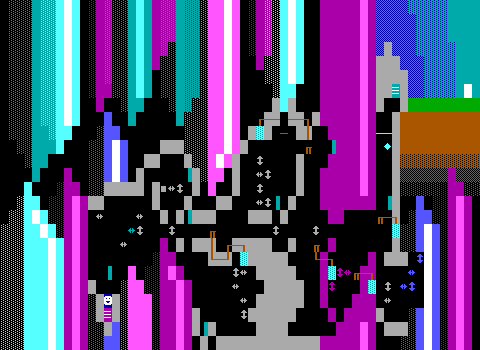
In Mount Heartache, the puzzles start off as their easiest. Very basic boulder and slider puzzles, none of which are intimidating serve as a soft introduction for the player. These puzzles consist of pushing pieces onto fake walls which are used as sensors. When the sensor is activated, small statues will move into new positions, offering Ana a chance to progress.
Originally, I planned to warn that for those new to ZZT this area could be a tad more annoying since incorrect solutions here can result in the player becoming stuck and having to restore a save, however in numerous cases pushing boulders where they end up blocking the path forward will result in hidden objects pushing them back out.
There are still some puzzles throughout Ana that can prevent progress, but Benco has done an admirable job making sure that as many mistakes can be reverted to a solvable state. There's a clear investment in this game's design to keep things accessible.
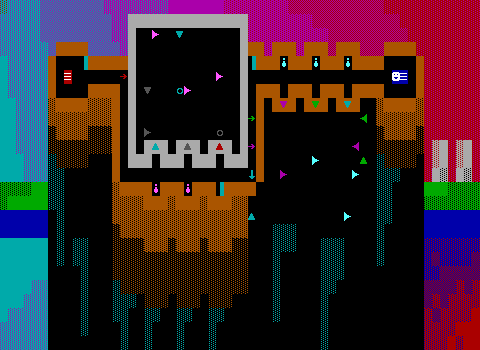
Mechanical Heights steps things up a bit with some more complex puzzle design. Here the puzzles are focused on shooting barriers by rotating arrows which shoot in the direction they point when they themselves are shot. The player will be given switches to fire bullets or rotate a specific color of arrows.
If the storytelling of Ana is reminiscent of Gone Home, the puzzles here bring back memories of Barjesse's Nightmare, a game that is often considered one of ZZT's finest for puzzles. Although you can go back even earlier into ZZT's history and see ricochet based varients of this sort of puzzle as early as City of ZZT.
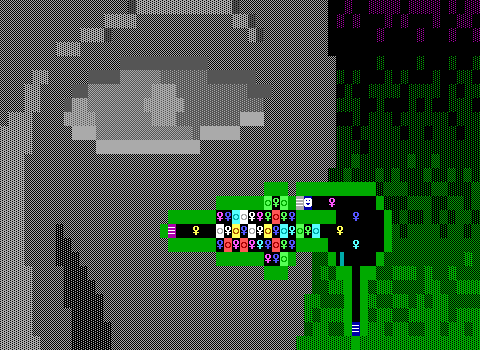
The third area, Felt Forest is my personal favorite. The story here is more compelling, and the puzzle design is something that you wouldn't really think of trying outside of ZZT
One common complaint people new to ZZT have is the limit of holding one key per color. Benco manages to take this rule of ZZT and create a series of puzzles about collecting the right keys to progress thorough increasingly complex mazes of keys and doors in close proximity. A key of a color that the player already holds is turned into a wall making it so that progress is made not by just unlocking doors, but by picking up a new key without any matching door in sight.
The key puzzles feel the most intense, and you'll find yourself carefully moving one step at a time, avoiding opening any doors unless you're confident that whatever is behind is the right path. Benco's interest in keeping things accessible makes me suspect that all of this is essentially an illusion. I'm not entirely sure you can trap yourself in this area, but it certainly feels dangerous.
(Making things even more tense is the fact that you'll often finish boards with excess keys, culminating in completing the area with a complete set of spares in your inventory.)

The final area of the game is the Palace of Self-Preservation, where the story and gameplay are revealed to be connected. Ana begins feeling like an arbitray combination of some good puzzles with some good story in a single game, but here it becomes clear that the two are intrinsicly linked together. You certainly could just read the story of Ana or play the puzzles without getting of the information, but the experience you'd get from either one on their own would not be Ana.
Here in the palace, the final set of puzzles involves a combination of positioning boulders to change the destination of ZZT transporters as well as flipping switches to rotate gates. After the forest, the palace feels less stressful and easier to make your way through, but ending with some comparitively faster puzzles works to the game's benefit as the story sippits reach a point where you'll be so engrossed in finding out how things are going to end that you want to get to the next letter as quickly as you can.
By the end you will be so engrossed in the story and worried about what's happening that the game's ending will have a tremendous impact. It's difficult to create strong emotional responses from ZZT games, but Benco does an excellent job of it.
The Music
Most ZZT worlds are pretty quiet. Many offer no sounds beyond ZZT's own noises of passages and transporters. Benco tries something different here and it works. Firstly, yes, there are sounds from interacting with the various objects that make up the puzzles, and they're pleasant and appreciated, but Benco has taken things in a different direction entirely.
Ana has its very own soundtrack! No PC speaker songs, but four well crafted tracks to accompany each region of the game. It feels rather strange at first, playing a 16-color text game with this music of such high quality attached. It's like an old Sega CD game where the audio quality is suddenly a mile ahead of the visuals, but the fact is it works and it works well. The music is what really ties everything together here. The music fits the atmosphere and tone of the game exceptionally well, and if you don't feel like manually changing tracks for each area, you'll still have things work out nicely if you just load the playlist and loop things throughout the entire game.
This approach to music for a ZZT game is something that I don't think would work with many ZZT titles, but since Ana has a constant theme throughout it, the four tracks fit wonderfully in a way that looping a few songs while playing a ZZT RPG or something wouldn't feel like every track is "correct" for what's going on in the game. I played Ana by looping the soundtrack and not worrying about location and it works well. For the video recording, I dubbed the proper track for each region in post production and that works quite nicely as well. Either feels valid, and as long as you have the soundtrack playing while playing Ana I believe you'll be getting the full experience. To play Ana without Benco's dreamscape audio to match the visuals would be a significant loss.
Overall
In the end, Ana is a ZZT game of tremendous importance. Years after the steady flow of releases has crawled to a near stop, Benco shows that not only can you still make a quality ZZT game in 2017, but that you can overcome the assumed snags of doing so. A ZZT game of this quality in 2017 is notable enough, but what truly stands out is that Ana isn't a complex engine doing things ZZT was never "meant" to be doing, but is in fact such a classically designed ZZT world. We're talking about boulders, sliders, bullets, keys, and transporters. Ana utilizes the classic 1991 style that fell out of favor, and brings back it into 2017 in a way that feels simultaneously old and new. It's a wonderful modern title that embraces its classical roots, and it manages to do so not by feeling like it's making an homage, but by building forward from them as a logical extension of what ZZT can do.
I wrote this featured game review for Ana rather than a traditional closer look article because I feel like screenshots of puzzles being solved and transcriptions of the game's story wouldn't do justice for the experience you'll have playing it. The game takes about an hour to complete, and I feel like it's an incredible must play game in general, ZZT or not. However, if puzzles aren't your thing, I've also recorded a playthrough of the game with the soundtrack dubbed over each area. Whether playing or watching Ana works best for you, I can't stress enough how solid this game feels. It's an hour well spent.




